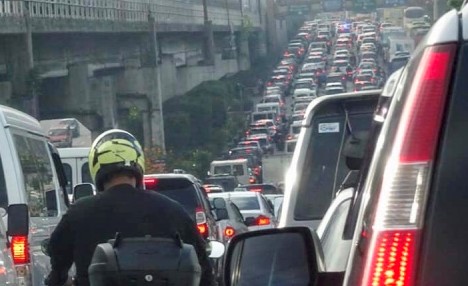Media report ECQ shift to modified quarantine as just another “carmageddon”

AFTER TWO months of lockdown, the government decided to ease quarantine restrictions in some areas. Modified levels were announced for different jurisdictions from May 16 to May 31. Modified levels of the ECQ included the modified enhanced community quarantine (MECQ), general community quarantine (GCQ) and modified general community quarantine (MGCQ). These would implement varying levels of strictness and restrictions. With exceptions, public transportation would still be suspended.
Media reports noted that the modified quarantine allows certain industries to return to operations, but with only up to fifty percent of their workforce. Companies that wish to reopen are encouraged by the government to provide shuttle services for their workers. Private vehicles used by employees reporting for work will be allowed, provided they present proper documentation such as a valid company ID.
After the extended period of lockdown throughout Luzon, a rush of movement was expected, raising concerns among authorities about the difficulty of implementing the rules under different quarantine scenarios. Their fears turned out to be well-founded.
According to the Metropolitan Manila Development Authority (MMDA), most of the vehicles that traversed the roads were cargo trucks and vans which were presumed to be the shuttle services provided by companies for their employees. As news accounts also noted, numerous private vehicles were asked at checkpoints to turn back for a variety of reasons, among them their lack of proper travel permits.
On the first day of the modified quarantine, media reports highlighted the return of “carmageddon” on major routes. Strict inspections at checkpoints in key locations caused bottlenecks which led to long queues on roadways, akin to seasonal holiday traffic.
These reports failed to reflect the inherent difficulty of implementing regulations involving contiguous jurisdictions that were also under different quarantine regimes. Seeing nothing more than the usual monster traffic, media coverage lacked the necessary insight and failed to point to the lack of clarity on the policies and its instructions for implementation.
CMFR monitored reports from the top three Manila broadsheets (Manila Bulletin, Philippine Daily Inquirer and The Philippine Star); primetime newscasts (ABS-CBN’s TV Patrol, CNN Philippines’ News Night, GMA-7’s 24 Oras and TV5’s One Balita); as well as selected news sites from May 16 to May 19, 2020.
What travel instructions?
Covering the first few days of the modified quarantine, the media picked up traffic issues brought about by the influx of vehicles in the streets. News accounts recalled that only essential travel was allowed, which has been the status quo for the duration of the lockdown. But most reports failed to clarify instructions for motorists intending to travel under the modified quarantine.
The reports noted that motorists had been turned away for reasons ranging from violation of social distancing measures, invalid reasons for travel to the lack of proper documents such as travel passes. Whatever the case, it was clear that many motorists were confused or uninformed about travel restrictions under the different levels of community quarantine.
For instance, 24 Oras on May 16 noted that some motorists leaving Metro Manila to return home to the province where they reside were turned away for lack of proper permits. In its May 19 report, it noted that some travelers from Metro Manila seeking to enter Cavite thought they could freely travel to the province since it is under the less restrictive GCQ.
Reports on traffic on this day should have been treated by journalists with a stronger policy orientation. The “carmageddon” was not the usual traffic story; it was more significant than the seasonal holiday rush. The coverage should have gone beyond the typical treatment of traffic jams and focused more on the issue of public information, or the lack of it.
It would have been appropriate for media to check on the necessary coordination and information dissemination, the details of which should have been clear and communicated to the public and the LGUs down to the barangays.
Three days later, a brief report on May 19 by Rappler summarized the guidelines for movement within and among areas under ECQ, MECQ, GCQ and MGCQ. To keep things simple, Rappler zeroed in on who and what are allowed to travel under any type of community quarantine, what is prohibited and what kinds of travel are permitted. The article referred to the announcement of Presidential Spokesperson Harry Roque, which was done on the same day. But no report pointed out the tardy announcement as another example of poor policy implementation, a characteristic that has doomed so many aspects of the administration’s strategy to fight COVID-19.
Leave a Reply